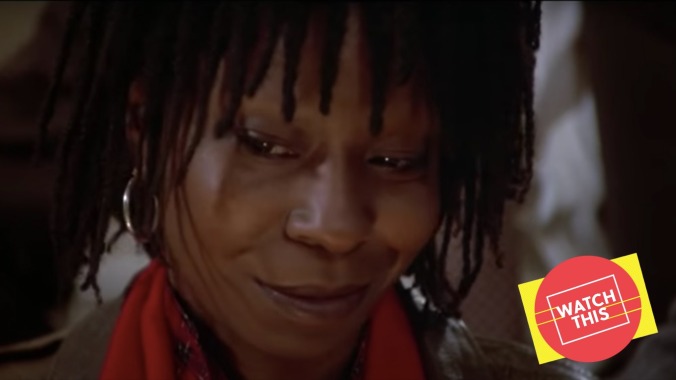In the late 1980s, Whoopi Goldberg was her own genre

Watch This offers movie recommendations inspired by new releases, premieres, current events, or occasionally just our own inscrutable whims. This week: February is Black History Month, so we’re looking back on great performances by Black actors that the Academy Awards ignored.
Jumpin’ Jack Flash (1986)
There are so many instances in her early career when Whoopi Goldberg was tasked with tackling a scene that could be reduced to “How odd, a Black woman is here.” Breaking through with her Oscar-nominated performance in The Color Purple following her triumphant one-woman show on Broadway, Goldberg was a performer whose talents were so unique and difficult to categorize that Hollywood had no clue how to fit her into any of the boxes of mainstream media. She would eventually win an Academy Award for injecting some life into 1990’s Ghost, but the five-year stretch in between her two dates with Oscar led to some of her most fascinating and provocative work, esteemed by connoisseurs of R-rated comedy but not by any awards body.
A chameleon who understands exactly where the fourth wall is but (almost) never crosses it, Goldberg recognized early on that Hollywood wasn’t going to create something for her, so she built her own genre. It makes sense that the troubled production of Jumpin’ Jack Flash was the means by which she was first able to tell the story of her own frustrations with the machine. Penny Marshall stepped in a month and a half into production after initial director Howard Zieff and initial star Shelley Long exited, and brought with her a hunger to prove herself as director. That same hunger allowed Goldberg to pull from multiple drafts of the script (by Nancy Meyers and David Mamet, among others!) and her own peerless improv skillset to create Terry Doolittle, the kind of complex Black female protagonist extremely rare in studio movies at the time.
Terry, like Bernie Rhodenbarr in Burglar and Vashti Blue in The Telephone, is a modern woman taking the pressures of life in a corporate, sexist, racist society and exploding them through canny observation and an awareness of the machinations of mysteries, action movies, and psychodramas. She works in computers in a way instantly familiar to contemporary audiences, facilitating international commerce via the internet before the general public had any idea what that even meant. She’s a helpful friend, comic relief at a moment’s notice (both for its own pleasure and as spiteful defense), quick with a wig in times of crisis, and a proficient code-switcher at a time when that concept hadn’t yet entered mainstream social discourse. Her sense of style: cable-knit sweaters and primary color accessories, mass-market paperbacks and movie posters.
Jumpin’ Jack Flash morphs into a comedic spin on the spy thriller. Throughout, Terry is fearless, both in facing danger and in her willingness to take a persona and run with it, either bending others to her will or making them retreat out of awkwardness, and slipping into caricature only to exploit someone’s unease and end a confrontation. The film’s standout sequence is a police-station showdown with a disaffected detective (the director’s brother and fellow filmmaker Garry Marshall). The scene’s funny but also raw, allowing Terry to vent her anger at a cop who’s callous and cavalier in wielding his authority, assailing the character of a Black woman he refuses to listen to. Thirty-five years later, the encounter still cuts; one can only assume Goldberg had to fight to preserve its rough edges.
We get glimpses, too, of something behind the shifting construct Terry wears in public: fear at finding a Polaroid of herself during an investigation, irrepressible joy in music and dance, an instinct for physical comedy as a paper shredder turns a Diana Ross dress into a Tina Turner skirt. At one point, Terry returns home after an evening of righteous triumph to find her apartment invaded, her belongings wrecked and scattered, and Goldberg lets the interplay of fear and exhaustion play across her expressive face. For once, the constructed bravado has fallen away—it’s a transcendent moment in a post-Color Purple career of weird genre hybrids, often MacGyvered from script fragments into something emotionally recognizable. In a better reality, Goldberg would have moved on from Jumpin’ Jack Flash and the like to more starring roles that best utilized her vulnerability, gift for mimicry, and savage wit.
Availability: Jumpin’ Jack Flash is currently streaming on HBO Max. It can also be rented or purchased digitally from Amazon, Google Play, YouTube, or DirecTV.